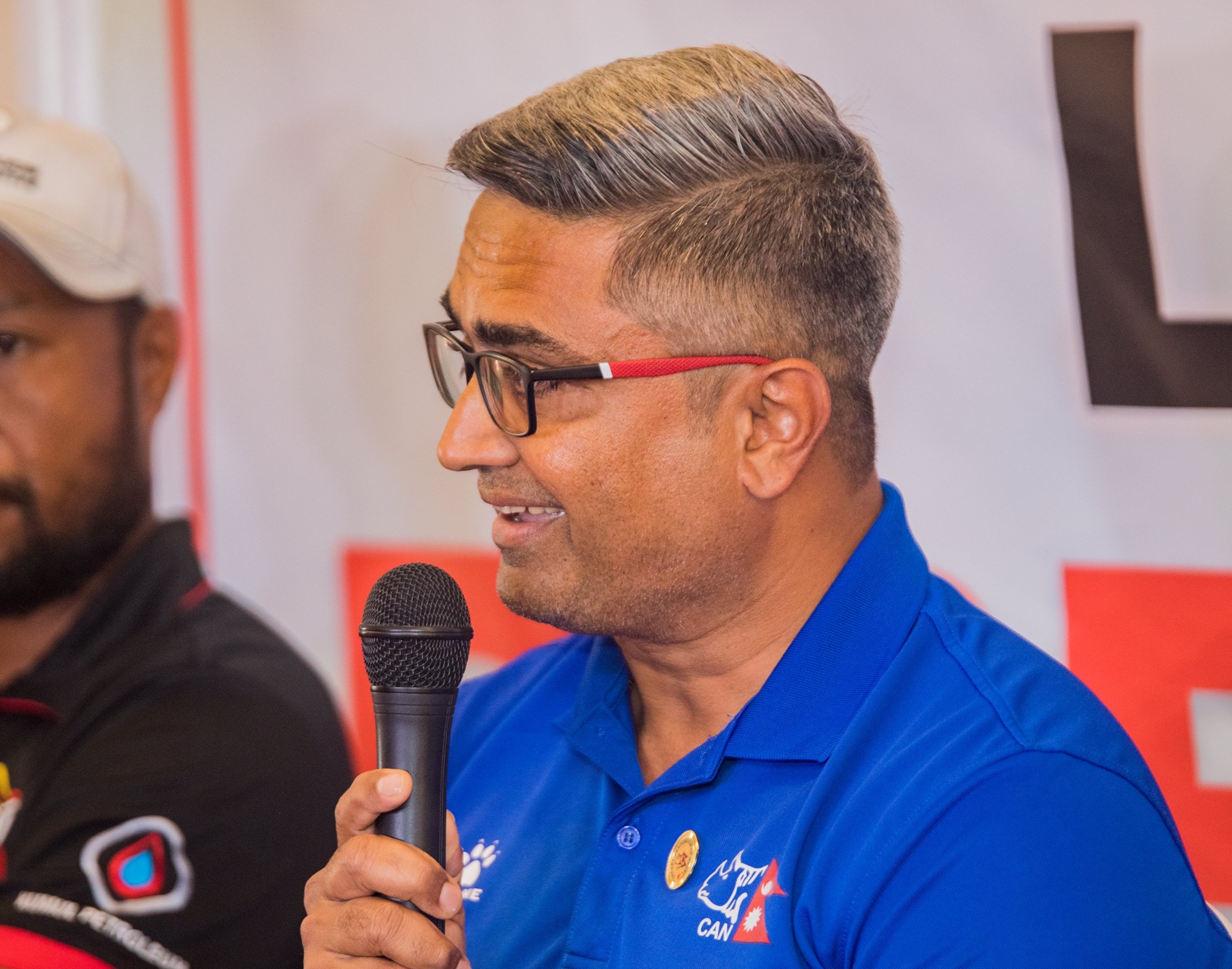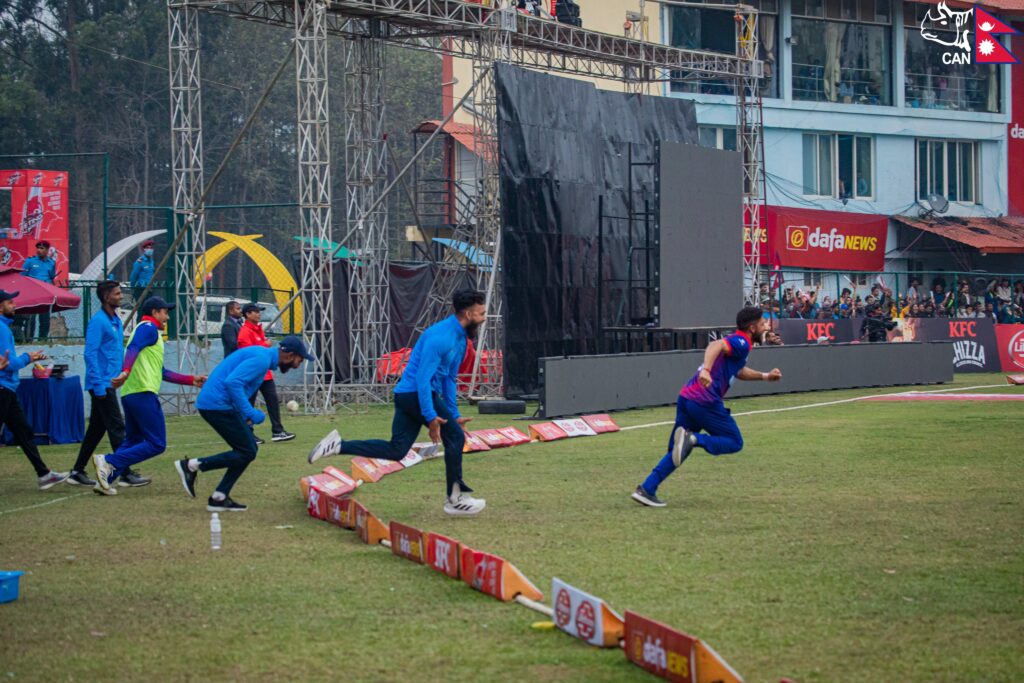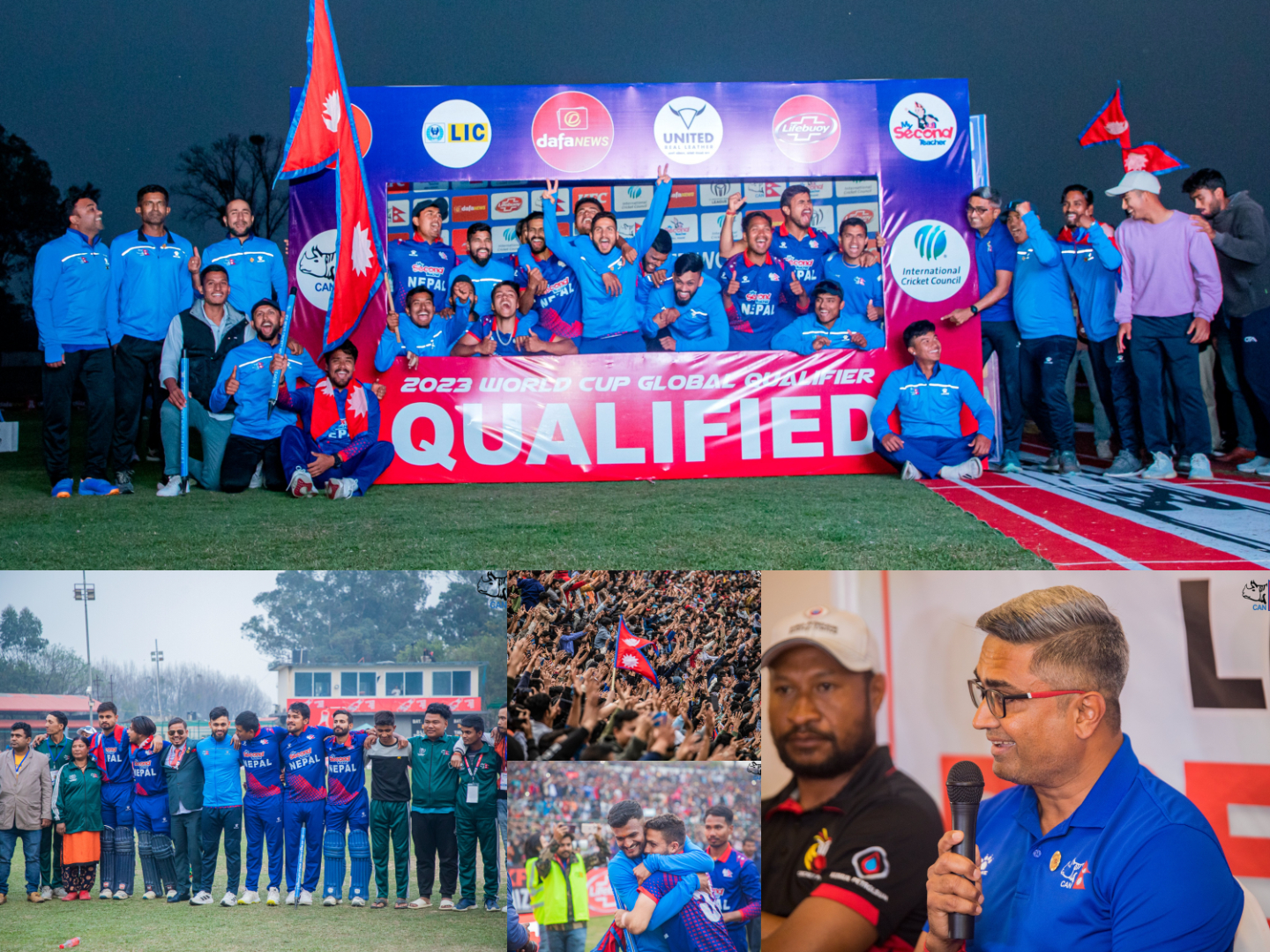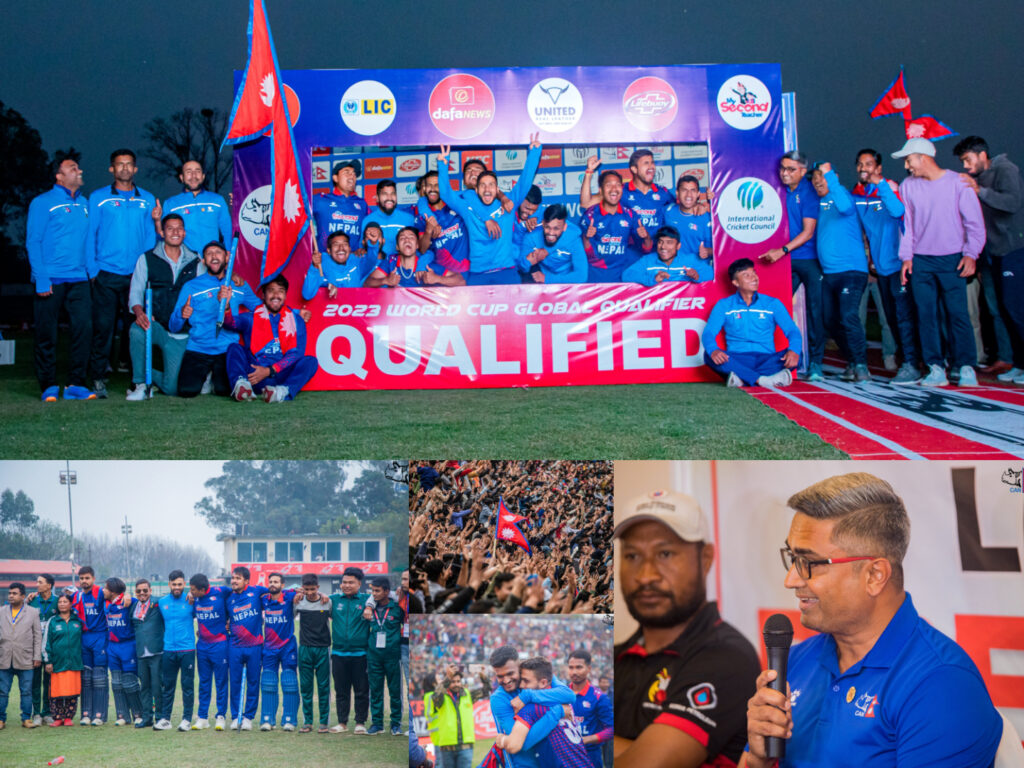
The sheer passion for Cricket in Nepal. PC – CAN
On March 16, 2023, there were dark clouds hovering around the Kirtipur stadium in Nepal. But while glancing through the wild celebrations at the stadium, it felt as if Nepal cricket’s brilliance on the field was courscating through the dull clouds up and above. The celebrations weren’t just restricted to those fans who were inside the stadium. But there was a frenzied atmosphere outside too, and perhaps all of Nepal. After all, Nepal had just gained an entry into the 50-over World Cup qualifiers on the back of defeating the UAE in a rollercoaster of a game by nine runs via the DLS Method. Gulshan Jha, who turned 17 last month, had virtually become a national hero after cracking a game-breaking fifty.
Nepal’s entry into the qualifiers was a culmination of a remarkable turnaround where they won 11 out of their last 12 matches. Just over a month ago, when Monty Desai took over as the head coach of Nepal, they were wallowing through a pile of defeats in CWC League 2. At that juncture, retaining the ODI status was their main goal. Incidentally, over a period of time, Nepal have promised much but only to crumble under pressure. It wasn’t necessarily related to lack of skill-sets as Nepal are blessed with a fair amount of talented players. It was something to do with the mental aspect of the game. The coaching staff was keen on bringing a change in mindset. Subsequently, Desai coined a new adage that helped Nepal’s players to carve out the right path.
“Our biggest mantra has been be 100 per cent present in those one-ball battles,” the Nepal coach says to Rev Sportz. “Nothing matters before the ball and nothing matters after the ball is bowled. Every ball is a separate story. The collection of those balls together, where you win some and lose some, is a result which gets concluded through different phases. For me, that has been the biggest win: the sporting culture that has changed their minds, creating the mindset of winning those one balls. Hopefully, that will end up getting us the results, which it actually did.”

It is true that a good coach is essential to set the foundation stone for a set of players to blossom. At the same time, the players also need to have the willingness to put in the hard yards in order to improve. Desai observes, “You know, guru shishya ka jo relationship jo bolte hai nah? (The rapport between a teacher and his student.) For me, if I only see it as a fan from outside, that was so evident. Okay, I have a certain responsibility to play a role. But, nibhana bhi ek cheez hota hai, players milne chahiye. (Taking responsibility is one thing, need players with the right mindset.)
“Self-management is where all these players stepped up, they started understanding the importance of staying in the present, they understood previously whatever they have done has not worked. So when the occasion arises, show courage and play a shot, which is not seen before. For example, Bhim (Sharki) played a ramp shot to Junaid and Zahoor, the bowlers were not expecting that shot. And we all agreed together that if someone plays a high risk shot like that and he gets out, no one is going to play the blame game.”
The first match under Desai’s tenure itself illustrates how the backroom staff’s ideas and thoughts were already ingrained in the minds of the players. Nepal were chasing a substantial target against the formidable Namibia side. The opener Kushal Bhurtel proceeded to compose a superlative 113-ball, 115 as Nepal emerged victorious by two wickets. The opener had laid down the marker for others to follow. Incidentally, before the game, Bhurtel was averaging just over 18 in 25 ODIs.
“Namibia scored 285, and that is the highest score chased by Nepal. If someone watches Kushal Bhurtel’s hundred in that game, he played some fearless shots, right from the start. He looked like he was in complete control of that game and set the tone for us. One player stepped up, and played with a free mind. I believe everyone started believing and stepping up in their own ways. Everyone brought in their A game, whatever was presented to them.”
To chisel out a side with a winning mentality, one more crucial piece of the jigsaw is needed: a captain who leads from the front and inspires the rest of the side to follow in the leader’s footprints. The Nepal captain Rohit Paudel is just 20 years old but since taking over leadership duties in November last year, he has showcased maturity way beyond his years. Desai narrates a couple of anecdotes that give evidence of his captain’s temperament. “When the 213-run chase (two-wicket win against Scotland), where our captain Rohit Paudel scored 95, he was very clear what position he wanted to walk in, he wanted to take responsibility upfront. He went there and played very positive cricket.
“In the last match, Rohit was clear of the fact that we want to score 70 plus runs in the Powerplay, if he had to lose an extra wicket, we don’t mind that. But we will take a risk. It is at the backend of the powerplay that we lost Rohit, trying to take a risk of attacking the left-arm spinner, going over mid-on,” he says.
Nepal’s tense two-wicket over Scotland once again brought to the fore that the entire set-up had imbibed the new culture that was laid by the management. “When Rohit kept on losing partners (at the other end), the very next batsman walking in, the message was very clear: stick with the captain and play out supportive roles. You could see from everyone walking with a ‘ yes’ message from their side with eye contact, that they were confident that they would go in and chip in there,'” the head coach pointed out.
In another of the CWC league 2 matches, Nepal were up against familiar foes, the UAE. Nepal had put up a decent total of 248 but the visitors seemed to have enough class in their batting unit to overhaul the target. Just that the home team’s bowlers put on a clinical show as the UAE were bowled out for a paltry score. Even the coach was pleasantly surprised by the brilliant performance.
“After we scored more than 240 in one of the final league games against the UAE, we were supposed to walk out to defend that score and we huddled up in the dressing room. Dipendra Airee stepped up and said, ‘sir, today is the day we will try to seize up the PowerPlay bowling and stay ahead of the game’. And I was telling them, ‘that is not possible, they are a good side, let us be very realistic, they will score around 40-50 and lose one or two wickets’. But they proved me wrong, they were very clear of what they wanted to do, we ended up picking so many wickets that we got them out for 70 odd.”

Desai continues to share little nuggets. Middle-order bat Aarif Sheikh was down with a bout of illness. He didn’t just convalesce from the illness but turned out to be one of the shining lights in a couple of Nepal’s wins. “Aarif was not well, he was sick, last minute we had to change the squad and keep him out against Namibia and Scotland. He slowly recovered, and then he was kept in the reserves squad, so he was coming on the ground, but he was physically not having the same strength.
“For him to watch all those games, process his own mindset while watching those games, and then when the opportunity came in UAE, stepped up and played a pivotal innings by being a glue in the middle and lower order,” he notes.
Aarif was more of the supporting cast in UAE’s come-from-behind win in Dubai. Bhim took the lead role by cracking a superbly paced innings. Bhim also essayed a vital hand in Nepal’s all-important match against the same opponent in Kirtipur. If we scratch the surface to get the bigger picture, Bhim wasn’t a part of Nepal’s set-up for a while. Just that Desai had seen glimpses of his immense potential during his time with the Nepal Under-19 side. Eventually, his gut feeling about Bhim turned out to be right.
“Kushal got a groin injury, then we had to bring in Bhim as a replacement. And Bhim was an absolute revelation for us, a player who was not even seen in the team, probably in the last year and a half. But I have some fond memories of this player from the Under-19 time, he played a particular role even in Under-19, which I was proud of, 15-20s he added as a counterattack against other Under-19 sides left a good impact on me on his mentality.
“So, when he came in the squad of 30, 20 and then to 14, taking all the learnings through the camps and practice scenarios, you know where he left the first impact? He scored 70 odd against UAE, it was an extraordinary innings he played. He showed so many times courage in that innings, playing shots that the opposite team was caught unaware. And then he continued the same form against UAE and PNG, he scored in all three vital games, putting us in good positions. So, for me he has been the biggest story within the story of our team. Coming from nowhere and performing so consistently. I hope he becomes a known player in associate cricket in a few years.”
Desai also chips in with words of praise for the man of the moment, Gulshan. Interestingly, Gulshan was set to be a part of Nepal’s Under-19 squad but the head coach and the rest of the think-tank had kept an eye on the young pace bowler and drafted him into the senior set-up. Gulshan also had a hidden talent: power-hitting. There was one more factor that caught the eye of both the coach and captain, which in turn tempted the duo to pick him for a few of the matches.
“Gulshan… he had to miss out on his Under-19 qualifiers. When I had a conversation with him, ‘what is your wish? You want to play Under-19s or play for the men’s team where you may not get all the chances, you will have a role to play’ he was very clear (about his goals and he said), ‘Sir, all your years you go up in the in the age-group ranks, one day you want to represent the national side’. I was so impressed by that comment.
“At the right time, when it was the most needed call for us, where we had only one left-hander at the top, and the question between I and Rohit was – what if Kushal Malla doesn’t come out good for us in this series? And the only back-up was Gulshan. So, we took that high-risk, high reward strategy, we had to explain KC Karan that he has done nothing wrong, purely for his extra option of left-hand batting we are going to swap him for Gulshan, how beautifully he stepped up in both games.
“When the moment came, fell just behind (DLS equation), we tried to go over-by-over to match up to the DLS. I was very keen for Aarif and Gulshan to finish it off for us. Obviously, to lose Aarif in that up-and-down, over-by-over situation, affected a little bit more. But then again Airee, when he walked in, he was also very confident. And God is great, we got that final opportunity against one weaker-link. Muhammad (Waseem) had to cover for someone else, I know that Junaid got injured, putting in so much of a big effort for them. Gulshan was able to play a hell of an innings in that one over itself. To understand what risk elements are involved in representing a particular skill and to execute it so well by clearly watching the ball and executing it under pressure was fearless,” he reckoned.
It wasn’t just the younger lot, but a couple of experienced cricketers also showed unstinting commitment to the vision of piloting Nepal to the qualifiers: Sandeep Lamichhane and Gyanendra Malla. It is true that Lammichane has been embroiled in a controversy. But if we stick to just his cricket for the moment, then he has plucked an astonishing 27 wickets in a mere 10 CWC League matches since his return to the side.
For his on-field performances, I do give him one credit: throughout in his attitude he showed a lot of gratitude for getting the chance. The mentality, the hunger, he has done some visualization of what he is going to walk into in the future, very much came back strong in his skills. He presented his skills straightaway and so many times he was able to plan and get the wickets, bowling a few overs and planning the batsman out, very happy to see the way he has performed for the team.”
Meanwhile, one of the mainstays of Nepal’s batting unit, Gyanendra, found himself out of the side on the back of compiling just 53 runs in his last six ODIs. But Desai had nothing but words of praise for the affable cricketer. He even compared his nature to that of an all-time great.
“Look, our highest partnership of these 12 games was between Gyanendra Malla and Aasif Sheikh (130). He has been involved in at least three 50-plus partnerships. Yes, he has set high standards for himself as well. Highly respected and humble. Of course, this is associate cricket story, there is no comparison when it comes to greats. But nature-wise, I would say he is very much like Rahul Dravid, very similar kind of attitude towards life (and) loves the sport deeply. And wants to contribute towards the goal.

“When we asked him to open, he opened. When we were very clear that if we had an injury to the keeper, he was supposed to take gloves. One day I made him warm-up his slow mediums. (Desai told) ‘maybe you need to chip in with a few overs’ (and) he was warming up 6-7 overs at a go. I still feel he has got something left for the team. It is a matter of time for him to get back to best form. What he contributes to players is unbelievable. His insights towards cricket, his insights towards associate cricket, he brings in a lot of logical information to the players. I have seen many players go and pick his brain, with technical aspects of batting.”
Nepal’s stunning run wasn’t just based on the key players finding their groove and performing at crunch moments, but it also had supporting actors. Just to illustrate the point further, a Ferrari is known as a beauty and beast all in one. But to manufacture the car, it also needs ancillary parts like titanium lug bolts and engine connector cables. For Nepal, there were quite a few players and members of the support staff who made timely contributions.
“Airee, canny off-spin that he bowls, the kind of batting he chips in with. I mean that extraordinary partnership (100 runs) versus Scotland, he and Kushal brought us back in the game. He is very calculated and so measured. They deep dived into their roles. And when the opportunity came, even they scored a six here and there.
“I had one person over here, who (deserves) some credit for what he did in the end. He played only one or two games in the first series, Lalit Rajbanshi. Five to six games for a person to sit out and then step up for a role which he was playing for – bowl with new ball, with so much zeal was amazing. Sandeep Jora (against Namibia), he went and played a 30 or 28-run knock where he just went after bowling, because that is what we wanted from him. I can’t discount all my staff, who worked 24/7.”
The Nepal coach adds a touching story, “Vikram, our physio, two times he had medical challenges, he stepped up, in a situation where his wife was under labour in US. What a wonderful story, a baby child taking birth and the physio taking care of the role given to him… extraordinary.”
Desai and co. aren’t resting on their laurels. After a small break, Nepal would look at chalking out plans for the upcoming Asia Cup qualifiers and the subsequent World Cup qualifiers. “For the moment, we have a week or 10 days of break and actually heading up into the Asia Cup qualifiers, which is hosted by Nepal. I know that all the associate teams are competing, we will get to play again against UAE and Oman who would be strong sides. I am hearing there would be teams like Qatar or Bahrain, some of the expats who have moved over there are making them strong, Hong Kong, if you remember, they played in the Asia Cup last time.
“We are hoping to go to Zimbabwe at least two weeks early or to a nearby nation two weeks early and prepare for the World Cup qualifiers. We will try to keep an eye on other teams who are already there and try to do some homework. You have some reasonable information about associates, that is the data which keeps getting collected as they keep playing each other, hoping that we will be able to outsource some of the things required for gathering information and then plan for the same and hopefully put our best forward.”
Desai also has long-term goals and that is for Nepal to take a flight to a different level and become a full-member nation. The sheer passion for cricket in Nepal gives an inkling that there is a lot of potential still to be tapped. The last game of CWC League 2 itself serves as an example.
“On this particular day, what was unbelievable to see was the kind of crowd which turned up. Not just inside the stadium but even people outside the stadium, all around the walls, to an extent they were over some of the panels just to have the visuals. And then like you said right up on the branches of different trees, we were watching, we could see right from the dressing room, I was concerned about it – what if someone falls? But that is the kind of craze, they were not having any fear in their minds, just wanted to look and bring in their energy, their belief on this team to cross the line for victory.
“The interesting part is look at the neighbouring countries around Nepal, and there are five full-member countries: India, Pakistan, Bangladesh, Sri Lanka and also you have Afghanistan. It was Afghanistan and Nepal who were going hand-in-hand in that subtle period and of course Afghanistan progressed further up and became a full-member team. I really hope Nepal becomes a full-member team,” he observes. “This is very sincere towards the full-member teams, if everyone can contribute something towards this cricket loving nation… setting up an academy and grooming the players, you will be surprised to see what wonders they can do at the highest level,” he adds.
At the moment, it is difficult to predict whether the memorable performance by Nepal in the CWC League 2 would serve as a springboard for further success. But there is no doubt that Desai and his wards have created a legacy with their epoch-making win against the UAE, something that would reverberate through the majestic mountains, forested hills, beautiful valleys and gushing rivers of Nepal for generations to come.




